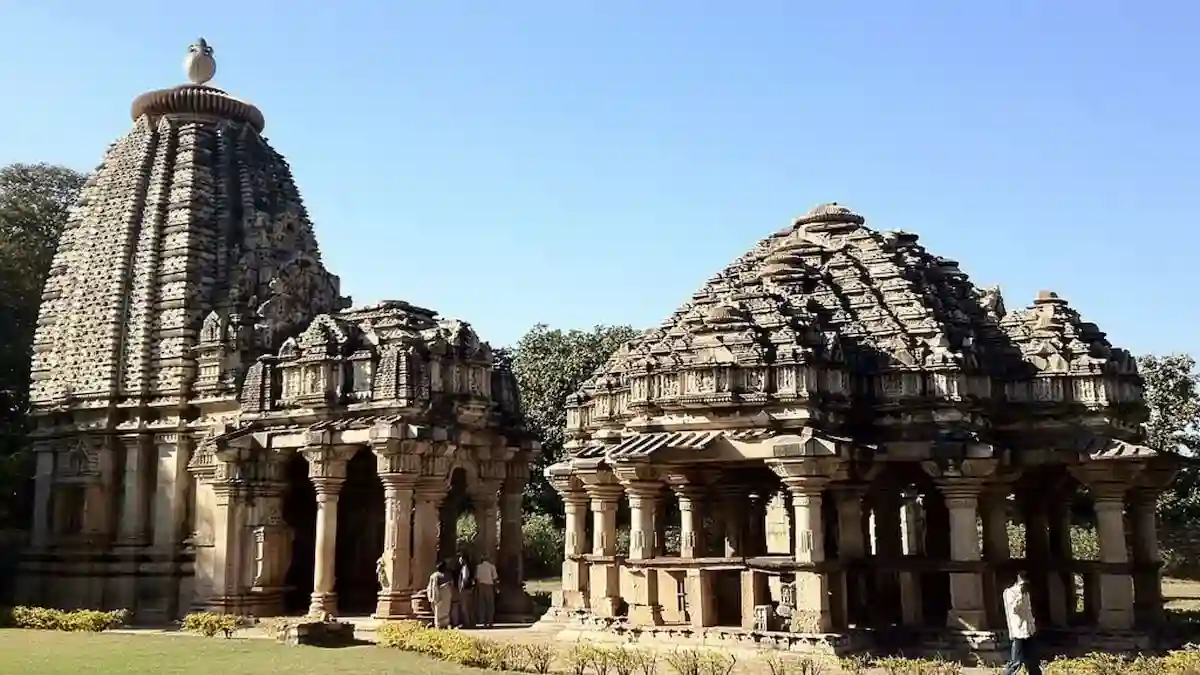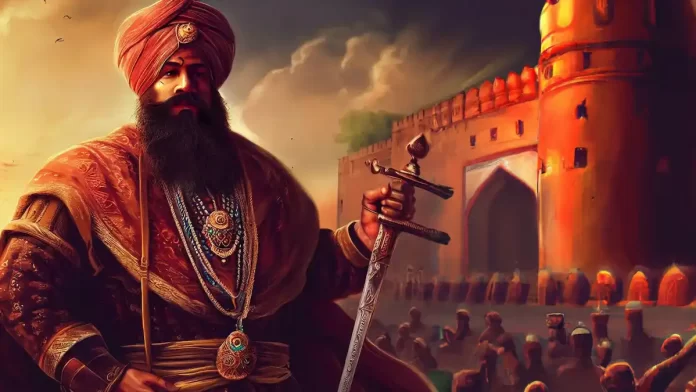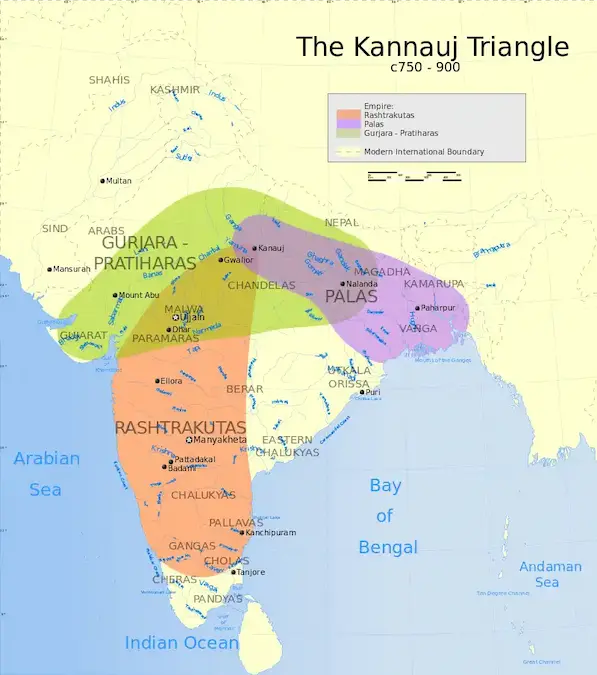The Gurjara Pratihara dynasty ruled vast portions of northern and western India between 700-1300 AD.
The Pratihara kings took the title of Maharajadhiraja of Aryavarta i.e. the king of kings of India. Arab traveler Al-Masudi referred the Pratihara Empire as “Al-Juzr” of India.
Their contemporaries were the Palas of eastern India and the Rashtrakutas of Deccan who engaged in a tripartite struggle for the control of Kannauj and fertile Gangetic plains.
Read this to learn more about the Gurjara-Pratihara dynasty, its origins, and history.
Origins of the Gurjara Pratihara Dynasty
According to most historians, the Gurjara-Pratihara dynasty had its origin in the nomadic Gujjar tribe.
In the Himalayas and Kashmir region, this tribe is still pastoralist. In the plains and Delhi NCR regions, they have now adopted a sedentary lifestyle. Many are now agriculturists and own vast tracts of farms.
According to Bipin Chandra, they were pastoralists and ferocious fighters like Jats.
First, they established small principalities in Rajasthan which later grew into a powerful state due to the efforts of able and stout leaders.
Their first capital was at Bhinmal. Later, it shifted to Ujjain and Kannauj.
Arab historians of that age tell us that while the Palas of Bengal had the best elephants, the Pratiharas had the best cavalry in India.
Also Read| Pala Dynasty: The Great Patrons of Buddhism in India
Administration of the Gurjara Pratiharas
Like Palas and Rashtrakutas, Gurjara-Pratiharas too inherited the basic administrative mechanisms and terminologies of the Gupta Empire.
During the Pratihara Empire, the following administrative posts were noteworthy-
| King: Maharajadhiraja |
| Chief of the Armed Forces- Senapati |
| Provinces- Bhukti |
| Districts- Mandala or visaya |
| Governor- Uparika |
| Head of a District- Visayapati |
| Smaller Chieftains- Samants or Bhogapatis |
| Village Headman- Grama Mahajana or Gram Mahattara |
| Royal Household- Antahpur |
| Court Priest- Purohita |
Important Rulers
Nagbhatta I
He was the first significant ruler of the Gurjara-Pratihara dynasty. He defeated an Arab army under Junaid and Tamin and resisted several other Arab incursions and campaigns into India.
Nagbhatta II
He was one of the most powerful rulers of the Gurjara-Pratihara dynasty.
Under him, the Pratihara empire reached its zenith and peaked further under his able successors Bhoja and Mahendrapala.
Bhoja
Historian Bipin Chandra calls him the real founder and greatest ruler of the Gurjara-Pratihara dynasty.
Also known as Mihir Bhoja, he is famous in Indian fables and legends for his adventures.
He was also a champion of art and culture. His court was a refuge for great scholars and poets of that age.
King Bhoja took titles like “Maharajadhiraja of Aryavarta” and “Adivaraha” and styled himself on the lines of Hindu God Vishnu.
Another king of the same name from the Paramara dynasty ruled Ujjain later.
Mahendrapala I
He was the son of King Bhoja and succeeded him in 885. He further extended the Pratihara Empire to Bihar and north Bengal.
However, his attempt to win over Punjab and Kashmir proved disastrous. He was not only defeated by the ruler of Kashmir but also had to surrender a large area as a war indemnity.
Mahipala
Mahendrapala was succeeded by his son Mahipala. The famous Sanskrit scholar Rajshekhara lived at his court.
He was the last powerful ruler of the Gurjara-Pratihara dynasty. After him, the Pratihara Empire declined rapidly.
Significant Events
Some significant events that took place during the rule of the Gurjara-Pratihara dynasty in India include-
The Devastation of Kannauj
The great city of Kannauj was sacked and burnt several times during the rule of the Gurjara-Pratiharas.
In our previous post on the Pala dynasty, we have already discussed how Pala ruler Dharmapala occupied the Pratihara capital Kannauj and held a grand Durbar there.
Rashtrakutas too sacked and laid waste to this beautiful city several times.
The final death blow to the city and the Pratiharas came between 915 and 918, when the Rashtrakuta king, Indra III, again invaded Kanauj and devastated it completely.
Resistance to Arab incursions
The Arabs under Muhammad Ibn Qasim had already captured the Sindh from King Dahir in 715.
However, their further advance into India was checkmated by Pratiharas and Chalukyas for over 300 years.
Though Pratiharas succeeded in preventing the Arabs from advancing further into India, they failed to protect their capital Kannauj from the Palas and Rashtrakutas who sacked and devastated it several times.
Pratiharas in general were hostile to Arabs. This hostility, however, did not prevent the scholarly and intellectual exchanges between Baghdad and India.
Also Read| Rashtrakuta Dynasty and the Rise of Kannadigas
Important Personalities during the Pratihara Rule
Al-Masudi
Al-Masudi was an Arab historian and scholar from Baghdad. He visited India during the rule of the Gurjara-Pratihara dynasty.
However, when he came to India, the Pratihara power was rapidly disintegrating.
They had already lost Gujarat and its rich sea trade to the Rashtrakutas for Masudi writes that the Pratihara empire had no access to the sea.
Al-Masudi refers to the Gurjara-Pratihara dynasty as “Al-Juzr” and gives a mesmerizing description of the Pratihara Army which according to him consisted of 7-8 lakh men.
Rajshekhara
Rajshekhara was a decorated Sanskrit scholar, poet, and dramatist in the court of the Pratihara king Mahipala, a grandson of Maharaja Bhoja.
Indra III
He was a Rashtrakuta king who invaded Kannauj twice and brought great devastations to the city and its residents.
Krishna III
He was a Rashtrakuta king who invaded the Pratihara Empire in 963. This event brought about a rapid dissolution of the Gurjara-Pratihara dynasty.
Devapala
He was a Pala ruler who defeated the Pratihara ruler Bhoja when the latter tried to invade Bengal.
Art and Culture
As already discussed, the Pratiharas patronized art and culture. They gave shelter to noted scholars, poets, and dramatists like Rajshekhara.
The adventures of Pratihara King Bhoja are still famous in India. He was influenced by Vaishnavism and styled himself as Vishnu.
As far as architecture is concerned, they decorated Kannauj with lavish buildings and temples.
However, the city faced death and destruction at the hands of the Palas and Rashtrakutas several times.
Some notable architectural wonders from the Gurjara-Pratihara era include-
- Teli ka Mandir, Gwalior Fort, Madhya Pradesh
- Jain caves of Siddhachal, Gwalior Fort, Madhya Pradesh
- Ghateshwara Mahadeva temple, Chittorgarh, Rajasthan
- Baroli temples complex, Chittorgarh, Rajasthan
- Mahavira Jain temple, Osian, Rajasthan
- Bateshwar Hindu temples, Madhya Pradesh
In 2018, the Archaeological Survey of India resumed the restoration work at the Bateshwar Temple Complex in Madhya Pradesh which houses over 200 temples from the Gurjara-Pratihara era.

Causes of Decline
The decline of the Pratihara Empire was a result of various factors, including:
- Internal Conflicts: The Pratihara Empire was plagued by internal power struggles and family feuds, which weakened its unity and stability.
- Invasions by Palas & Arabs: The Pratiharas were constantly threatened by invasions from neighboring as well foreign powers. These included the Pala dynasty from the east and Arab armies from the west. These invasions took a toll on the Pratihara military and weakened their hold over the empire.
- Economic Decline: The Pratiharas relied heavily on agriculture for their economy, but droughts and famines led to a decline in agricultural production and weakened their economic base.
- Rise of New Powers: The emergence of new powers, such as the Rashtrakutas and the Palas in Bengal, challenged the dominance of the Pratiharas and led to a shift in power in the region.
- Decline in Religious Influence: The Pratiharas were known for patronizing Hindu-Brahmanism but the decline of their political power also led to a decline in their religious influence.
Overall, the decline of the Pratihara Empire was a result of a combination of internal and external factors that weakened its power and influence.
Positive Sides
The positive sides of the Gurjara Pratihara Dynasty include-
- They had humble tribal roots in the nomadic Gujjar tribe.
- Filled the administrative void created by the fall of the Gupta Empire.
- If Palas maintained the largest number of Elephants, the Pratiharas had the best cavalry in India.
- Pratiharas patronized art and culture.
- Stopped the Arab campaigns in India.
- Embellished Kannauj with beautiful buildings.
Negative Sides
Some negative aspects of the Gurjara Pratihara Dynasty include-
- They did not pay much attention to the defense and fortification of their capital Kannauj which was sacked and destroyed by the Palas and Rashtrakutas several times.
- Given their roots in a subaltern nomadic tribe, they should have worked responsibly for the upliftment of their tribal brethren, pastoralists, Bahujans and Shudras who remained oppressed, poor, and illiterate. Instead they patronised Brahmanical classes who in turn oppressed Bahujan-backwards.
- Pratihara rulers undertook some unnecessary military campaigns which proved disastrous.

